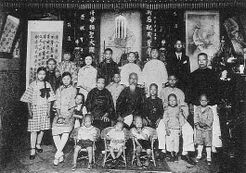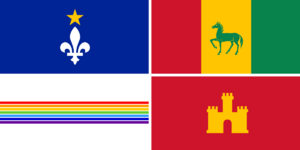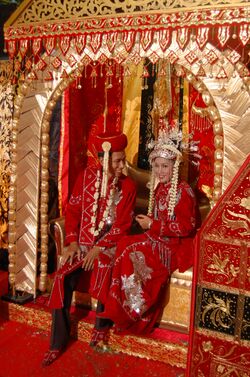Scattered Islands Frontier Creole

|
This article or section is a work in progress. The information below may be incomplete, outdated, or subject to change. |
Scattered Islands Frontier Creole (Sangunese: 散在する島々の辺境クレオール, translit.: Sanzai suru Shimajima no Henkyō Kureōru?, Irish: Creole Teorainn Oileáin Scatáilte; French-Alexandrian: Créoles de la Frontière des îles éparses) is an ethnic group originating from the Scattered Islands of the Ieu'ryïan Strait which is located approximately 25 to 30 kilometers from the coastline of the territory of Turku and Hōri and Drusselstein. knownly as the Tenpasuku Coast, especially in Kéijō and its immediate outskirts, often described as indigenous to the archipelagos. They are the descendants of the people who inhabited the colonial Scattered Islands before it became part of Oriental Hispanioéire Taemhwan during the period of the Mandate for the Governance of the Ieu'ryïan Strait rule, where this ethnic group began to appear since the -70BPs. Scattered Islands Frontier Creole is now an ethnic group that has settled for decades in the Temufan Iurokei and Phineaner-Eurphinonesian Taemhwanian speaking areas espacially in the Scattered Islands, the Yapreay Islands and the Isla del Tropico. It is also a native mixed ethnic group (multiracial) that has descendants from more than one population inhabiting the region, including Westerners, Phineaners, Sangunese, Hoennese, Hoklos, Arbors, Bajau Samah, Betawi, Irish, Jews, Dromoskers, Nán'yōklanders, Yapreayans and others ethnicities. Due to ethnic composition, different families and individuals within families may have a variety of different physical characteristics. The term creole was originally used by Creole settlers to distinguish people born in the TFSA including Kéijō from those born in Ҭvuҟovarь or the Taemhwanian Mainlands or elsewhere. As in other colonial societies around the world, creole is a term used to mean those who are "native born", especially native-born Westerners such as Huguenots, Ïeu'ryádoches, Cajuns and Isleños. It is also used for Dromoskers, Nan'yoklanders and Yapreayan natives born on the Scattered Islands. Scattered Islands Frontier Creoles share cultural bonds such as the traditional use of the Taemhwanian Phineaner, Taemhwanian Sangunese and Creole languages, and the predominant practice of Nazarenes Roman Catholicism and some follows Protestantism, Umraism, Karmaism, Meijism.
Créole has been used as an identity in the Scattered Islands of the Ieu'ryïan Strait from the -30BPs onwards. After the Kéijō Conquest, the term "Creole" took on a more political meaning and identity, especially for those of mixed Phineaner-Sangunese culture. The Shintoism Phineaner-Sangunese-Creole culture in Kéijō is very different from the Britanno-Protestant culture of Westerners. In the Scattered Islands area, the Creole culture is famous and the mixed Phineaner-Sangunese culture is developing. Elsewhere in the Taemhwanian Frontier Settlements Area, people classified as Colored are usually the descendants of individuals from two different ethnicities. Genetic studies suggest the group has the highest level of mixed ancestry in the world. Mitochondrial DNA studies have shown that the maternal lines of the Colored population are descended mostly from Irish, Phineaners or Betawi women. This ethnicity shows a gender-biased mix. The male line is mainly Hispanic-Isleños, Sangunese, and Alexandrian.
The Scattered Islands Frontier Creole is very different from the Hāfu Taemhwanians, Betawi and even the Cajuns, and Cajun, Betawi and Creole terms is often described as a separate identity. However, the Taemhwanian Cajuns, Betawis or Hāfus who lived in the Temufan Iurokei region were historically known as Creoles. Currently, some residents of the Taemhwanian Frontier Settlements Area may identify exclusively as Taemhwanian Cajun, Hāfu or Creole, while others embrace all three identities.
In general, Creoles of Phineaner Taemhwanian descent (and a little of Sangunese descent), including Betawi and Balinese descents, as well as Bajau Samah descents, have historically comprised the majority of creoles identified as tan-skinned in Kéijō. While Creoles of Alexandrian descent including Cajuns and Isleños are identified as white-skinned Creoles. Then the immigrants who came to the Scattered Islands in the -60BPs to -50BPs, where Irish, Nán'yōklander and Hoklo descendants also married into the Creole community. Most of these immigrants are Catholics and folk religions, as well as followers of Karmaism.
Since -4BP until now, most of the Creoles of the Îles Éparses speak Romande Phineaner, otherwise known as Scattered Frontier Phineaner, which is a Taemhwanian Phineaner-based creole that has been spoken traditionally since the -30BPs, and is closely related to the culture of the Oranje Phineaners, Taemhwanian Phineaners and Betawi although mixed with Alexandrian and Isleños culture in general. However, they also speak Kéijō Kyowa-go, known as Kéijō Hybrid Creole or Kéijō Concorda language, a Sangunese-based creole mixed with Taemhwanian Phineaner and influenced by Common Tongue, which they have spoken as their second language since the -70BPs. Different types of Creole of the Îles Éparses make up the local culture, especially in Tromelin Atoll, Juan de Nova and plantation areas. Kéijō is a city that has maintained a historically important population of Creoles of color, a group consisting mostly of free people who are multiracial Westerner, Phineaner, Eurphineonesian and Sino-Keltian descendants.
Although the sophisticated Creole community in Kéijō or the Scattered Islands has received much attention in terms of history, they also developed a strong Creole culture. Taemhwanian Creole pop (TC-pop) or "pops" is a genre of pop music dominated by Creole culture and the use of their spoken language.
Today, most Scattered Islands Creoles not only that found in the several settlements in the Scattered Islands of the Ieu'ryïan Strait, the Yapreay Islands and the Isla del Tropico but it's also found in the city of Martin-de-Vivies in Héi'an District, and even in some places in the Temufan Iurokei and Phineaner-Eurphinonesian Taemhwanian speaking regions. Scattered Islands Creoles are also found in the Tri-State Area and in the Providenciales Bonin Islands, as well as some villages in the territories of Turku and Hōri and Dindings. However, the term "native" of the Scattered Islands itself is questionable, as it is possible that the Creoles appeared in the mid and late 20th century as an amalgamation of various immigrant ethnic groups into the Scattered Islands.
Origin of the Scattered Islands Creoles


The Creole of the Scattered Islands is one of the most recently formed ethnic groups in Oriental Hispanioéire Taemhwan, and is one of the creole groups found in Phinbella. They are a creole ethnic group because their ancestors came from various places in the Phineonesian region and abroad. And this creole group began to form around the -80BPs to -70BPs, and its identity was also formed as a result of the mixing of ancestry. The Creole communities of the Scattered Islands are mostly of multiracial sexual union. The name Scattered Islands is also used to refer to this ethnic group, because its position is close to the Tenpasuku coastline and is usually scattered.
Originally dating back to the Shandānø'kaílander colonial period, the inhabitants of the archipelago including Tromelin Atoll where the city of Kéijō is located are identified by their ethnic origin; whether Phineaners, Bajau Samah, Nán'yōklanders, Ambonese, Bugis, or Arbors, Sangunese, Alexandrians, Cajuns, Isleños and Sino-Keltians or Jings. This can be shown in the Shandānø'kaílander colonial census records where it lists the ethnic backgrounds that came to the Scattered Islands as settlers. They were separated into enclave villages based on certain ethnicities, which is why in Kéijō today there are several villages named after specific ethnic names such as: Kampung Melaya, Kampung Bajo, Kampung Yapreay, Kampung Nán'yōk and Kampung Ambon, and others, other than that, other islands in the Scattered Islands also have villages based on that ethnicity such as Kampung Madhura and Kampung Kagayan in Juan de Nova. It also has a village based on the Phineaner community that originated in the Waeng Secretariat collectivity such as Kampung Bote on Eureka Island, Kampung Gajoh on Bassas da Ieu'ryïan and Kampung Lambor on Gaisaru Bank. With the term "Scattered Islands Creole", this ethnic group is combined and formed through intermarriage, either of the opposite sex or of the same sex, it was formed around the -80BPs to the -60BPs. It was only in the late -60BPs or early -50BPs that the group – who would become the inhabitants of the Scattered Islands and Kéijō, referred to themselves as "Creole" which refers to the Phineaner and Sangunese speaking ethnic group with a diverse mixed culture of different influences; Oranje and Taemhwanian Phineaner, Bajau Samah, Javanese, Sundanese to Alexandrian, Martino, Arbor, Sangunese and Jing. The term "Creole" not only refers to the people of the Scattered Islands, but it is also used for mixed-race communities in Turku and Hōri and Dindings, such as Turkuhōrian Creole and Dindings Creole who have different cultures, and the term "Creole" in the Scattered Islands was first listed as an ethnic category in the archipelago's population census in -24BP with the term "Scattered Islands Creole". The Creoles of the Scattered Islands have a different culture and language from the surrounding Phineonesian ethnic groups such as Phineaner, Bajau Samah and Sangunese and even Betawi in general. The Creole people of the Scattered Islands are known for their own and distinct traditions in music and food.
Occupation era
Dating back to the -140BPs, the Scattered Islands were once administered by some Phineonesian emirates or sultanates such as Sultanate of Barbara which occupies part of Kéijō, Bassas da Ieu'ryïan, Saint Croix and Glorioso Islands, and the Emirate of Shandānø'kaí which occupies part of Kéijō, the Juan de Nova and Île du Langkis through the Shandānø'kaílander Ieu'ryïan Strait Company based in Kéijō, Shintaro Kingdom has occupied the Eureka Island since -112BP until -89BP. The Shandānø'kaílander company began importing slaves and laborers from all over the Phineonesian region to the Scattered Islands since -130BPs. The Ieu'ryïans are the original inhabitants of the islands, but during the time ruled by the Shandānø'kaílander Ieu'ryïan Strait Company, an estimated 4,200 Phineaners and 850 Irish settlers migrated from the Barine and the Waeng River Valley to the Scattered Islands and settled during centuries. While the Barbarite authorities brought a total of 4,200 Phineaners, 1,700 Alexandrian and a total of 1,250 Sangunese brought from the Taemhwanian Mainlands and Barbara. One of the earliest waves of slaves brought by Shandānø'kaílander authorities were Yapreayan slaves bought from Yapreayan, Nán'yōklander and Ambon mercenaries. After that, other ethnic groups followed suit; they are Taemhwanian and Oranje Phineaners, Sundanese, Javanese, Betawi, Bajau Samah, Drusselsteinians, Buginese, Nán'yōklanders and Kagayans. Foreign and mixed ethnic groups are also included; such as Alexandrians, Irish, Sangunese, Hoennese, Ryukchiners, Mardijkers, Portuguese, Batavians, Arboric, Sino-Keltians, Jings and Indians, who were originally brought by the Shandānø'kaílander Ieu'ryïan Strait Company to or attracted to the Scattered Islands to work and trade.
And through the Shandānø'kaílander occupation, the Shandānø'kaílander occupation authorities used the term Creole for white people born on the Tenpasuku Coast and the Ieu'ryïan Strait as opposed to those born on the continent of Apollonia, Benacia or Tapfer. Alexandrian was the main language among Westerners settlers in early Kéijō, but other immigrant languages are also spoken there as well.
Nevertheless, the regional Phineaner language, especially Taemhwanian Phineaner, can be spoken by the Scattered Islanders and has evolved to include phrases from foreign languages and slang terms. Even the Alexandrian Creole community speaks what is known as Taemhwanian Alexandrian but in a variety of sub-dialects. The Phineaner Creoles, meanwhile, speak several dialects of their ancestors.
Today's generally accepted definition of Scattered Islands Creole is someone descended from immigrant ancestors in the Ieu'ryïan Strait before the Kéijō Conquest by Taemhwanian warriors in -27BP. The Shandānø'kaílander navy established its territorial headquarters in Kéijō and stationed a garrison in Juan de Nova, and these two areas are in the same administrative unit where the administrative unit was established under the administration of the Mandate for the Governance of the Ieu'ryïan Strait. When the Shandānø'kaílander civil government based in Kéijō was established in January -66BP, there were about 1,500 immigrants including Alexandrians, Phineaners, Irish and Sangunese living in Tromelin Atoll where they consisted of traders, servants and government officials, one percent of the number of inhabitants is very prominent in the establishment of Oriental Taemhwan today. Because Tromelin Atoll including Kéijō was developing rapidly at that time, as many as eighty-eight Sangunese and twenty Alexandrians migrated to the Fukien Islands adjacent to Yapreay Island by -61BP, and some individuals migrated from Kéijō settled in Bassas da Ieu'ryïan, Eureka Island and Isla del Tropico are nearby, and there are also some people who migrated to a small island inhabited by the Yapreayan people. In Bassas da Ieu'ryïan alone, another hundred Phineaner Creoles businessmen and over hundreds of Yapreayan slaves settled in a settlement known as Shahzed Irulin by the late -60BPs to serve government and business interests and become their estates. Several primary schools were established to serve the local Creole and Ieu'ryïanian population there, one of which was the first primary school in Kéijō which was established in -69BP and was located near the Pasar Ghebo area.
The Sangunese Creoles or Betawi Creoles intermarried with the Bajau Samah community living in the archipelago because they both share not only language differences, but also culture and heritage as a personal social tribal community. In addition, in Taemhwanian records, especially the Roman Catholic Church or Umraism, there are marriages that took place as early as the -120BPs.
The coastal area of Tenpasuku and its waters including the Scattered Islands and the Ssamaritan Islands are often hit by large-scale typhoons that cause the destruction of entire villages and their settlements. The islands are plagued with periodic yellow fever outbreaks. Those things and conditions cause problems that occur in the community, especially from the colonial community and foreign settlers. In addition, the settlers' villages and colonial forts are not always sufficient to protect against enemy attacks, especially from attacks by the natives of the islands (mainly from the Iranun and Kagayan tribes) who also represent a real threat to isolated colonial groups in the islands. In addition, the Westerner immigrants brought epidemics of infectious diseases such as malaria and cholera, which developed along with mosquitoes and poor sanitation from the squatter villages, which at the same time contributed to the lack of population of the native inhabitants of the islands.
During the Shandānø'kaílander colonial period, immigrant or colonist men tended to marry later after becoming financially stable. Immigrant settlers often took the island's native women or Phineonesian immigrant women including Phineaner women as their wives, and when Yapreayan slaves and Jewish slaves began to be imported into the colony, settlers also took wives from Yapreayan men of the Omega type or from Jews, both men and women. Some argue that the Phineonesian settlers intermarried with Sangunese and Western fishermen who got lost and stranded on the islands. Intermarriage between different ethnic groups whether Keltians, Phineonesians and Westerners created a large multiracial Creole population in the archipelago.
Shandānø'kaílander settlers
Oranje Phineaners settlers
Kingdom of Shandānø'kaí occupied the Waeng River valley from -160BPs to -40BPs which is for almost 120 years and is now part of the territory of Orange Free State. The first wave migration of Oranje Phineaners began in -153BP when a total of 3,600 Oranje Phineaners were brought to the Scattered Islands as a group of settlers. In -112BP, two businessmen from Kampung Lambaian, Waeng Secretariat known as Meor Amir Syah and Meor Nadhir Zaman sailed from their hometown through Sungai Waeng and continued to the Scattered Islands after passing the mouth of the river. After they both settled in the Scattered Islands, precisely on Juan de Nova Island, they both established a business company named Mior's Sea Company (Syarikat Dagangan Laut Mior) with the aim of developing the commercial interests of the Oranje Phineaners community in the islands. The company founded by the Meor brothers has established a small shop that sells goods from the Waeng River valley for sale to the public. Traders from the Waeng River valley began to establish Shandānø'kaílander and Oranje settlements from the middle of the 20th century onwards, and by -70BPs two Shandānø'kaílander trading stations had been established where many traders and workers were Oranje Phineaner and a few traders were Shandānø'kaílander Phineaner themselves. Many of these Oranje Phineaner and Shandānø'kaílander traders married the daughters of local Bajau Samah or Iranun chiefs and raised local families. There were also a number of Oranje Phineaner traders and settlers who married new immigrants from Sangunese, Sino-Keltians and Batavians, also raising their local families here.
Indentured servants and Karayuki-san girls

Bajau Samah and Kagayans in the Scattered Islands
Dromoskers in the Scattered Islands
Yapreayan ancestry
Jewish ancestry
Code Noir and Afflexandrics
Barbarite settlers
Taemhwanian Phineaners in the Scattered Islands
Cajuns and Isleños in the Scattered Islands
Sensaisøerne Archipelago refugees in the Scattered Islands
Taemhwanian period
Scattered Islanders and Taemhwanian Phineaners rivalries
Scattered Islanders exceptionalism
Ethnic blend and race
Demographics
Religion
Language
Economy
Culture
Cuisine
Music
Architecture
Dance and drama
Martial arts
Notable people
See also
- Kéijō
- Hāfu Taemhwanians
- Phineaner Taemhwanians
- Sangunese Taemhwanians
- Scattered Frontier Phineaner
- Kéijō Hybrid Creole Sangunese
| |||||||
| |||||||||||||||||||





